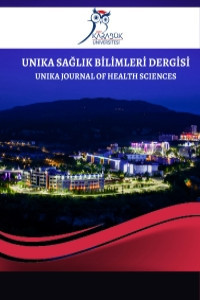Muğla Bölgesinde Üretilen Ballarda Antibiyotik Kalıntılarının Araştırılması
Arı yetiştiriciliğinde tedavi sağlamak, verim artırmak, kolonilerde hastalıkları önlemek amacıyla kullanılan antibiyotikler arı ürünlerinde kalıntıların varlığına neden olmaktadır. Kalıntı bulunan gıdaların insanlar tarafından tüketilmesi antibiyotiklere karşı direnç gelişmesine, zehirlenmelere ve teratojenik, mutajenik, karsinojenik etkilere neden olabilmektedir. Bu çalışma, Muğla bölgesinde üretilen ve tüketime sunulan ballarda, insan sağlığı açısından olumsuz sonuçları bulunan tetrasiklin ve sülfametazin kalıntılarının tespit edilmesi amacıyla yapılmıştır. Muğla merkez ve 12 ilçesinden 7’şer adet olmak üzere toplanan 84 adet bal numunesi ELISA test kitleriyle analiz edilmiştir. ELISA test sonuçlarına göre incelenen örneklerde; tetrasiklin antibiyotik, örneklerin %58,3’ünde (n:49) pozitif bulunmuş, %41,7’si (n:35) negatif bulunarak antibiyotik kalıntısına rastlanmıştır. Sülfametazin ise örneklerin %100’ünde (n:84) pozitif varlığı tespit edilmiştir. ELISA testinin kalıntı yönünden sadece tarama yapması nedeniyle, elde edilen sonuçların daha hassas ileri tekniklerle kontrol edilmesi gerekmektedir. Çalışmanın bulguları, yapılan bilimsel çalışmalarla da karşılaştırıldığında paralellik ve benzerlik gösterdiği görülmektedir. Bu demektir ki yasal olmamasına rağmen bu antibiyotik türevleri halen arı hastalıklarıyla mücadelede bilinçsizce kullanılmaktadır. Arı yetiştiricilerine arı hastalıklarıyla mücadelede etkili yollar açıklanmalı, eğitimler verilmeli, insan ve toplum sağlığına olumsuzlukları anlatılarak bilinç geliştirilmelidir.
Anahtar Kelimeler:
Antibiyotik, Bal, Kalıntı, Muğla
Examination of Antibiotic Residues in Honey Produced in Mugla Region
Antibiotics used in bee breeding to provide treatment, increase efficiency and prevent diseases in colonies lead to the presence of residues in bee products. Consumption of foods with those residues may give rise to resistance to antibiotics, poisoning and teratogenic, mutagenic, carcinogenic effects. This study was carried out within the scope of Mugla region to identify any presence of antibiotic residues of tetracycline and sulfamethazine which have negative consequences for human health. 84 samples collected from central Mugla and its 12 districts were analyzed via ELISA test kits. According to the ELISA test results, the existence of the residues of tetracycline was identified positive in 49 of the samples (58.3%) and 35 of them (41.7%) were examined as negative. Sulfamethazine was found present in all of the samples. Nevertheless, as the ELISA test only scans for residues, the results obtained from this study had better to be controlled and revisited with more precise advanced techniques. When the findings of the present study are compared with the previous scientific studies, it is seen that they have parallelism and similarity. This indicates that these antibiotic derivatives are still used unconsciously in the fight against bee diseases even if it is not legal. Effective ways to combat bee diseases should be explained to bee growers and trainings should be given on the negative effects of excessive and illegal use of antibiotics on human and community health.
Keywords:
Antibiotic, Honey, Residue, Muğla,
- Başlangıç: 2021
- Yayıncı: Karabük Üniversitesi
Sayıdaki Diğer Makaleler
Esra YILMAZ, Reyhan AYDIN DOĞAN
Muğla Bölgesinde Üretilen Ballarda Antibiyotik Kalıntılarının Araştırılması
Hatice BAĞCI, Hidayet YAVUZ, Mehmet ÖZDEMİR
Okul Öncesi Öğretmenlerinin Çocuk Yetiştirme Tutumlarına İlişkin Görüşleri
Cerrahi Hastasında Cilt Temizliğinde Antiseptik Ajan Kullanımı: Bir Derleme
Işıl IŞIK ANDSOY, Mehmet ÖZDEMİR
